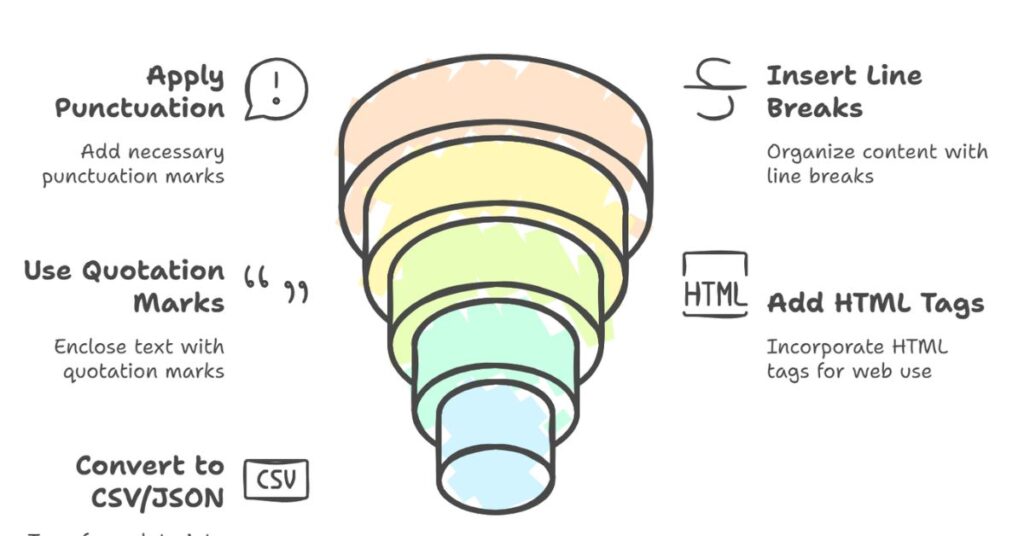Why Proper Data Formatting is Essential for SEO & Marketing
Table of Contents
As a CSE engineer with experience in digital platforms, I often see how poor data formatting creates issues in both SEO and marketing operations. Clean, structured data not only helps machines process content better but also allows teams to manage content at scale. SEO depends on how search engines read and organize data, while marketing tools rely on clean inputs for automation. In this article, I will explain how formatting data correctly helps improve SEO rankings and marketing efficiency.
What Is Data Formatting?
Data formatting means converting raw or unstructured content into a clean and consistent structure. This includes using correct punctuation, line breaks, quotation marks, HTML tags, and separators. For example, converting a text list into CSV or JSON is a form of data formatting. Search engines, crawlers, and marketing tools require structured inputs to read and use data accurately.

Why Data Formatting Matters in SEO
Helps Search Engines Read Content
Search engines crawl websites to understand their content. If data is not well-formatted, crawlers may skip or misread it. For example, a product list without HTML tags may not get indexed properly. Using <ul>, <li>, <p>, and <strong> tags tell the crawler what each element represents. This increases visibility in search results.
Improves Page Load and Index Speed
Clean HTML code loads faster and uses fewer resources. When content is formatted properly, servers process pages faster. This reduces crawl delays and allows search engines to index more pages in less time. Google also favors faster pages in rankings.
Supports Structured Data Markup
Schema.org markup is a structured format used for SEO. It helps search engines show rich snippets like FAQs, ratings, and product details. These snippets increase click-through rates. However, this only works if data is formatted in JSON-LD, Microdata, or RDFa formats. Poor formatting breaks schema tags and stops them from displaying.
Prevents Duplicate Content Issues
Unformatted data often leads to repeated content blocks. This confuses search engines and causes duplicate content penalties. Proper formatting groups content by type, which makes it easier to identify unique sections. For example, meta descriptions, headings, and canonical tags should follow a strict format.
Why Data Formatting Is Critical for Marketing
Enables Marketing Automation
Marketing platforms like Mailchimp, HubSpot, or Salesforce use data inputs to send emails, segment users, and run ads. These systems fail if the data is inconsistent. A CSV file with unquoted values or missing separators can break a campaign. Clean formatting ensures reliable automation and accurate audience targeting.
Improves Data Accuracy
Well-formatted input helps avoid errors during import or processing. For example, separating values with commas and wrapping strings in quotes reduces parsing errors. This is vital when syncing user data, tracking interactions, or running analytics.
Enhances Cross-Platform Compatibility
Marketing involves multiple platforms: CMS, email tools, analytics, and CRMs. Each system needs a consistent data format to read and write information. If one platform exports in TSV and another requires CSV, conversion becomes necessary. Standard formatting saves time and avoids data loss during transfer.
Real-Life Examples of Poor Formatting Impact
A product feed uploaded to Google Merchant Center failed because of unescaped characters in the title field.
An email campaign was sent with broken merge tags due to missing double quotes around variables.
A blog post is indexed without its main keyword because of missing <h2> tags.
In each case, better formatting would have prevented the issue.
Best Practices for SEO-Friendly Data Formatting
Use Consistent Structures
Maintain the same format across all content. Use <h1> for titles, <h2> for subtopics, and <p> for body text. In lists, use <ul> and <li> to show structure.
Wrap Values Properly
Wrap string values in double quotes when working with CSV or JSON. This avoids errors when a string contains commas or special characters.
Remove Extra Spaces
Extra spaces can confuse parsers and crawlers. Always trim white space before or after a value.
Escape Special Characters
In HTML and XML, characters like <, >, and & must be escaped. Use <, >, and & to avoid markup errors.
Tools to Help Format Data
Many online tools can help format text into HTML, JSON, or CSV. These tools offer features like:
- List wrapping in quotes
- Comma separator conversion
- HTML tag insertion
- JSON key-value formatting
Such tools speed up your workflow and reduce manual errors.
Final Thoughts
Proper data formatting supports both technical SEO and digital marketing workflows. It allows search engines to read content correctly and marketing systems to process user data without issues. As someone working in the IT sector, I have seen how simple formatting fixes can improve campaign results and search visibility. When you treat data formatting as a core step, you avoid errors and increase the impact of your content.
Leave a Reply